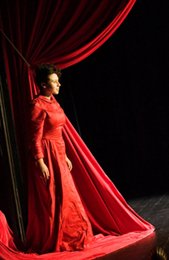A few furry spectators mark their territory as the audience file in to watch the National Youth Theatre’s production in the Peacock theatre. The humanoid bunnies that fill a few seats, and eventually kick off the performance by eyeballing us from the gallery, are an obvious nod to Wonderland, or even Donny Darko. Although quickly hidden from sight, for Caryl Churchill’s version (2005) of August Strindberg’s A Dream Play (1901) this quirky conceit nicely sets the tone for a drama that confounds the distinction between reality and fantasy.
 The action begins as Agnes, a daughter of the gods, descends from the heavens to explore life on Earth. Played by Janna Kemperman in a white dress, and Leah Minto in red, Agnes observes struggles in love, economics, politics and philosophy everywhere she turns. To show kindness to one person is to inflict pain on another, and life seems barely worth living. This absence of meaning and purpose gives rise to the assumption that truth lies behind “the door”, knowingly marked ‘stage door’ in Fay’s production. Scientists suspect it will reveal a logical rationale, while theologians hold out for divine insight. When the door is eventually prised open at the end of the performance to expose nothing, Fay would have us believe that the creative process is perhaps our most important resource.
The action begins as Agnes, a daughter of the gods, descends from the heavens to explore life on Earth. Played by Janna Kemperman in a white dress, and Leah Minto in red, Agnes observes struggles in love, economics, politics and philosophy everywhere she turns. To show kindness to one person is to inflict pain on another, and life seems barely worth living. This absence of meaning and purpose gives rise to the assumption that truth lies behind “the door”, knowingly marked ‘stage door’ in Fay’s production. Scientists suspect it will reveal a logical rationale, while theologians hold out for divine insight. When the door is eventually prised open at the end of the performance to expose nothing, Fay would have us believe that the creative process is perhaps our most important resource.
The 16 actors from youth theatres all around the country play approximately 39 roles in total. They initially deliver the dialogue in earnest, although this quickly gives way to plenty of humour. Playing the love-sick Officer, Tadhg Buckley’s deadpan commentary on romantic affairs frequently raises laughs. Hilary Bowen-Walsh gives a wonderful performance as the Officer’s mother and Edith, sliding between fey and histrionic. Under Liz Roche’s choreography, and in keeping with dream dynamics, the large ensemble randomly appear and disappear, sometimes pausing to provide moments of formal restraint. They deftly pool together to raise characters in the air, to suggest an assault, and occasionally to sing and dance. It’s a clever way to get so many performers on stage, not to mention focus the otherwise fluid action. Bach is juxtaposed against The Smiths and Jacques Brel, with the more contemporary tunes infusing a welcome kick, even allowing the actors to head-bang at one point. Under Sharon Sexton’s vocal direction, in one particularly strong moment the ensemble harmonise their melancholic groans.
.jpg.aspx%3Fwidth=400&height=161) Ferdia Murphy’s design draws attention to the theatricality of the dreamscape, with a large velvet curtain bordering the stage. Characters veil and unveil action in the background by drawing transparent gauzes, and bulbs hang at different lengths above the set, with colour changes portending trouble or simply signalling a scene change.
Ferdia Murphy’s design draws attention to the theatricality of the dreamscape, with a large velvet curtain bordering the stage. Characters veil and unveil action in the background by drawing transparent gauzes, and bulbs hang at different lengths above the set, with colour changes portending trouble or simply signalling a scene change.
In his preface to the original edition of A Dream Play, Strindberg writes “Everything can happen, everything is possible and probable. Time and place do not exist.” Churchill certainly loosens Strindberg’s language to resonate in the present, and there are occasions in this production where Fay exploits some anachronisms for the sake of humour and irony, such as with the rabbits and the music choices. Overall, however, the production is quite faithful to its turn of the 20th century origins. Agnes aside, the costuming choices suggest this, as does the projection of paintings by Edvard Munch (Strindberg’s contemporary and sometime collaborator) on the back wall towards the end of the performance. If the production had explored further the wackier possibilities afforded by a dream play, perhaps even by reintroducing the bunnies at the end rather than Munch, the result might have been more playful and weirder than it is. A small point, perhaps, in a production that suitably challenges its performers, and rewards the audience with the results.
Fintan Walsh is staff writer with ITM.